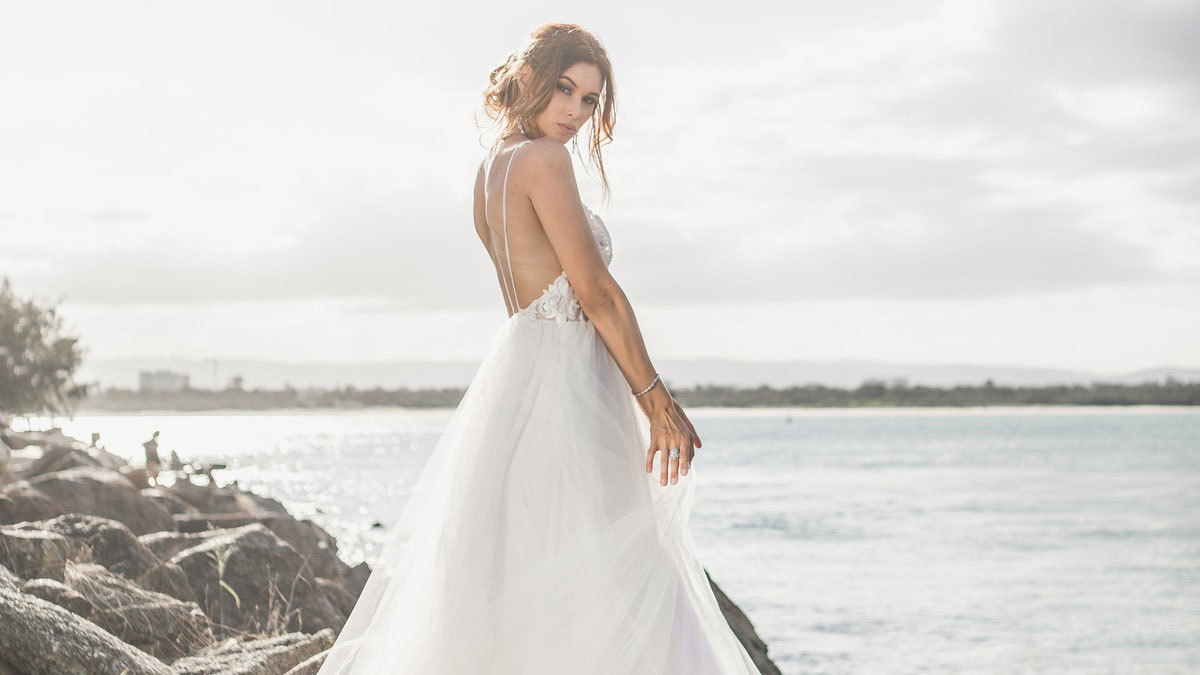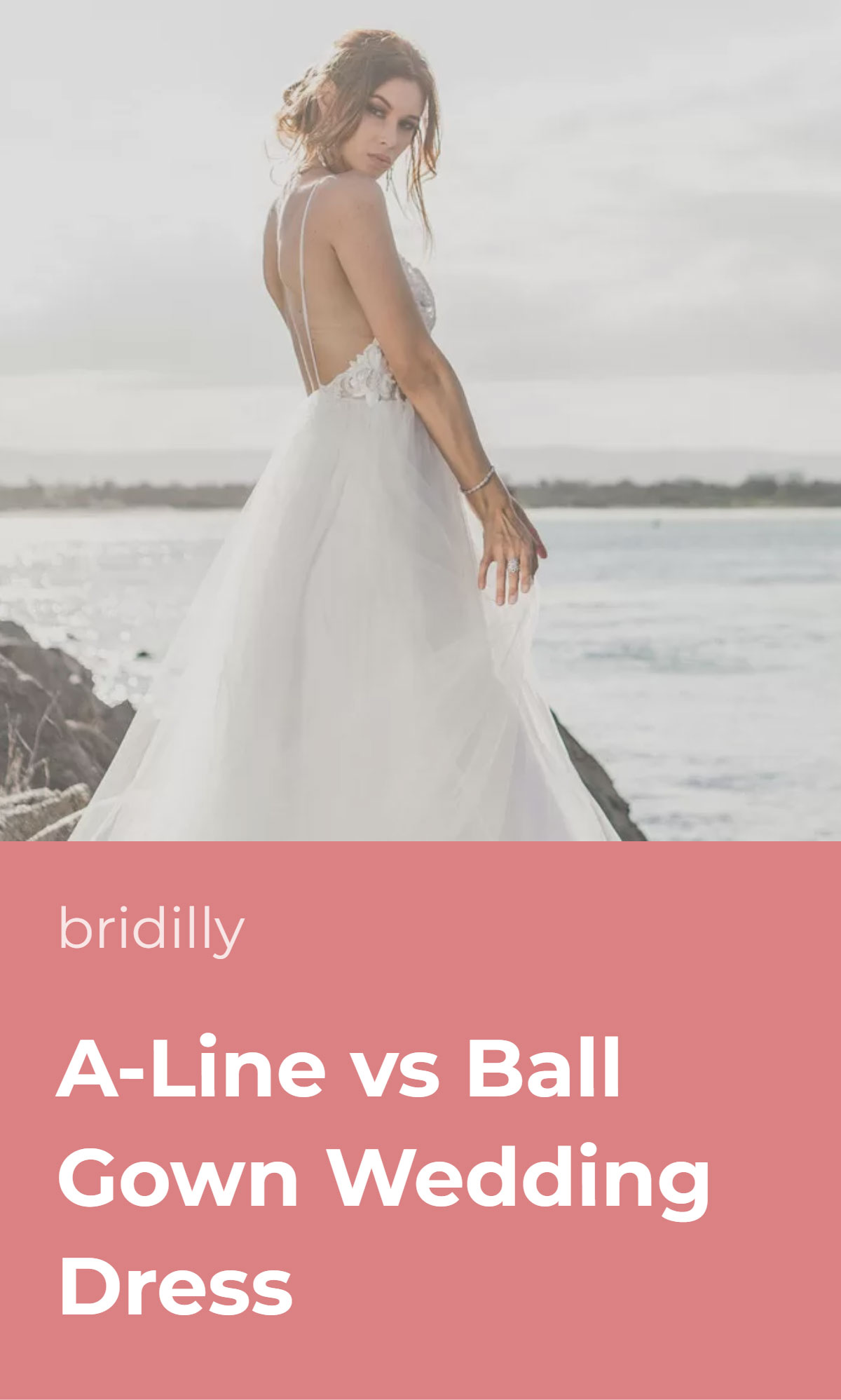Many brides have trouble distinguishing between an A-line vs. ball gown cut. Indeed, these silhouettes have a lot in common.
A-line and ball gown are the most popular and flattering wedding dress styles on the market, but learning the difference is vital.
Choosing the wedding dress silhouette is undoubtedly an exciting moment. However, the considerations don’t end with your emotions and style preference.
Different wedding dress styles suit different body types, and every bride wants a dress that would flatter her figure. Furthermore, some silhouettes are more comfortable than others.
Choosing your favorite will be easy as pie once you learn how A-line and ball gown wedding dresses differ.
Table of Contents [show]
Bodice
A-line wedding dresses come in all styles. There’s no limit on the neckline, sleeve, or bodice type – an A-line wedding dress can have a relaxed or corseted top, long sleeves, or no sleeves.
Meanwhile, most ball gowns have corseted bodices. The corset may be visible and serve as a style statement or be hidden in the inner part of the bodice. A corset in a ball gown is necessary to create the signature shape.
Note that this rule isn’t set in stone. Rarely you may come across ball gowns without corsets. In this case, the bodice is typically made from thick, robust fabric to handle the heavy skirt.
Waistline
The waistline silhouette in an A-line and ball gown styles also differs. Both dress styles are fitted at the waist, but A-line wedding gowns have a more natural cut and lower waistline.
You can recognize a ball gown by the enormous waist to hip ratio. The narrow waist dramatically contrasts with the wide skirt. The transition from bodice to skirt is never gradual and natural.
In the case of A-line wedding dresses, the waistline typically lies on the upper part of the hips and isn’t as defined as in the ball gown style.
If an A-line dress’ bodice and skirt are made from the same fabric, defining the waistline transitioning isn’t as straightforward. In ball gowns, it’s always apparent.
Skirt
The skirt is the main difference between A-line and ball gown wedding dress silhouettes. Even when the bodice is the same, you can easily distinguish these styles by the skirt’s flare.
While both the A-line and ball gown wedding dresses execute volume, the A-line has a more gradual flare. It’s fitted at the upper part of the hips, naturally flaring in shape resembling the capital letter “A,” thus the name.
On the other hand, the ball gown wedding dress style has an oversized, extra-voluminous skirt. The difference between waistline and skirt is defined, and the flare isn’t natural like that in an A-line dress.
The flare of a ball gown starts at the waist’s narrowest part. Meanwhile, it begins at the waist or upper part of the hips in an A-line dress.
These seemingly minor differences result in entirely different silhouettes – flowy and relaxed in the case of A-line dresses and dramatic in the case of ball gowns.
Pay attention to the skirt’s construction and fabric. A-line gowns may have skirts from lightweight and layered or rich, heavy material, but rarely with crinoline.
Ball gowns, in turn, often have crinoline sewn in the hem to give the skirt more volume. Some ball gowns don’t feature any crinoline but have numerous layers of fabric.
Ball gown dress skirts are typically made from fabric that keeps shape, like taffeta or organza. Meanwhile, A-line wedding dresses are usually made from softer materials that facilitate natural skirt movement.
Sometimes, you may come across wedding dresses with a gradually flaring skirt that’s full at the hem, often with crinoline. Such silhouette can be classified as either of the two styles or as a princess-cut wedding dress.
Princess-line wedding gowns are a hybrid between A-line and ball gown styles. Think of them as a dramatic take on the classic A-line cut.
As for the hem length, both styles can be floor-length or mid-length. Long ball gowns are the classic variation, but tea-length and knee-length options are perfect for brides who love the style but don’t want to compromise dancing comfort.
Style
The A-line wedding dress style is deservedly considered the most versatile and traditional.
This elegant silhouette is appropriate for any wedding theme, season, and location. A-line wedding dresses are perfect for modest brides who value tradition.
Depending on the fabric and design, an A-line wedding dress will look equally chic at a backyard barbeque party and in an exquisite venue. A-line wedding gowns can be very different, so there’s a style for every bride.
The ball gown is a sophisticated, dramatic style for brides who love to stand out. If you choose a ball gown wedding dress, be ready for extra attention. This gorgeous silhouette requires an equally exquisite setting.
Ball gowns aren’t appropriate for rustic weddings or informal receptions. This glamorous silhouette looks the best in luxurious venues and castle ballrooms. It’s an excellent choice for brides who’ve always dreamt of a fairytale wedding.
A ball gown wedding dress is also suitable for a church ceremony, provided that the bodice isn’t overly open and seductive.
Comfort
An A-line wedding dress is not solely the most versatile but also the most comfortable wedding dress cut.
That’s especially true for A-line dresses without corsets. The fitted yet unrestrictive bodice lets the bride breathe, not cinching the waist and bust.
A-line dress skirts flow freely, facilitating ease of movement – it’s an excellent wedding dress style for dancing. The only exception is A-line wedding dresses with dramatic trains.
On the other hand, ball gowns aren’t the best choice for a laid-back bride who loves to dance without restrictions. The voluminous skirt creates space between partners, which can become a real problem during the couple’s first dance.
Furthermore, ball gown skirts are heavy. Even if the dress is made from lightweight organza, the layers inevitably add weight. Then, add embellishments and high heels. Carrying such weight throughout the entire day can be tiring.
Thankfully, ball gowns aren’t nearly as restrictive as the trumpet or mermaid wedding dress styles that chinch the legs, preventing the bride from even walking freely.
The good news is that you can learn to dance in any wedding dress style – yes, even in a mermaid gown.
Practice is vital, so if you opt for the ball gown silhouette, practice dancing in it at least a couple of times before the big day.
Another point to note is the corset, which can be present in both dress styles. Corsets make the silhouette more attractive, but they aren’t easy to walk in for long periods.
Over time, you may have trouble breathing in a tight corset, especially after a good meal. This issue can be resolved by loosening the corset, but you need to find someone to do it for you.
Keep in mind that you may also require assistance when using the restroom or taking the stairs in a ball gown.
Body Type
The A-line wedding dress cut is truly the most versatile and not solely in terms of style. It also fits every body type, including pear, rectangle, inverted triangle, and hourglass.
The natural waistline and gradually flaring skirt create flattering proportions. It magically makes the waist narrower and the hips wider. The key is to find a neckline style that suits your figure.
Furthermore, the long skirt, natural waistline, and gradual flare visually elongate legs and make the bride appear taller.
Simply put, A-line wedding dresses fit anyone – it’s no wonder that this silhouette is the most popular choice.
While A-line and ball gown silhouettes are similar, the latter isn’t nearly as versatile when it comes to body types. The full skirt and corset bodice create a dramatic waist-to-hip ratio, which may be both a pro and a con.
Brides with a rectangle, apple, or inverted triangle body type will appreciate the effect, as the dress cut will make them look curvier. A ball gown dress also perfectly balances fuller bust, making the figure appear harmonious.
Hourglass and pear-shaped brides will love how the ball gown silhouette defines the waist and skims over the hips.
However, it isn’t a good fit for brides wishing to show off their hips – fit-and-flare styles are more flaunting for legs and curves.
Petite brides should be careful with the ball gown silhouette. The voluminous skirt may make the figure appear shorter and bulkier, “swallowing up” the body. Extra-high heels may solve the problem, but fittings are a must.
Price
Both the A-line and ball gown wedding dress styles are available in any price range. Silhouette typically doesn’t affect the price as much as fabric or designer.
However, the amount of fabric necessary for a ball gown and the construction complexity can impact the cost. Ball gowns often have richly embellished corsets and layered skirts, which lead to a higher average price.
Naturally, an A-line dress from luxurious taffeta with delicate beading will cost more than a ball gown from pure polyester.
But sparing on ball gown’s fabric quality isn’t a good idea, as layers of synthetics will make you perspire.



















No Comments Add one
Leave a Comment